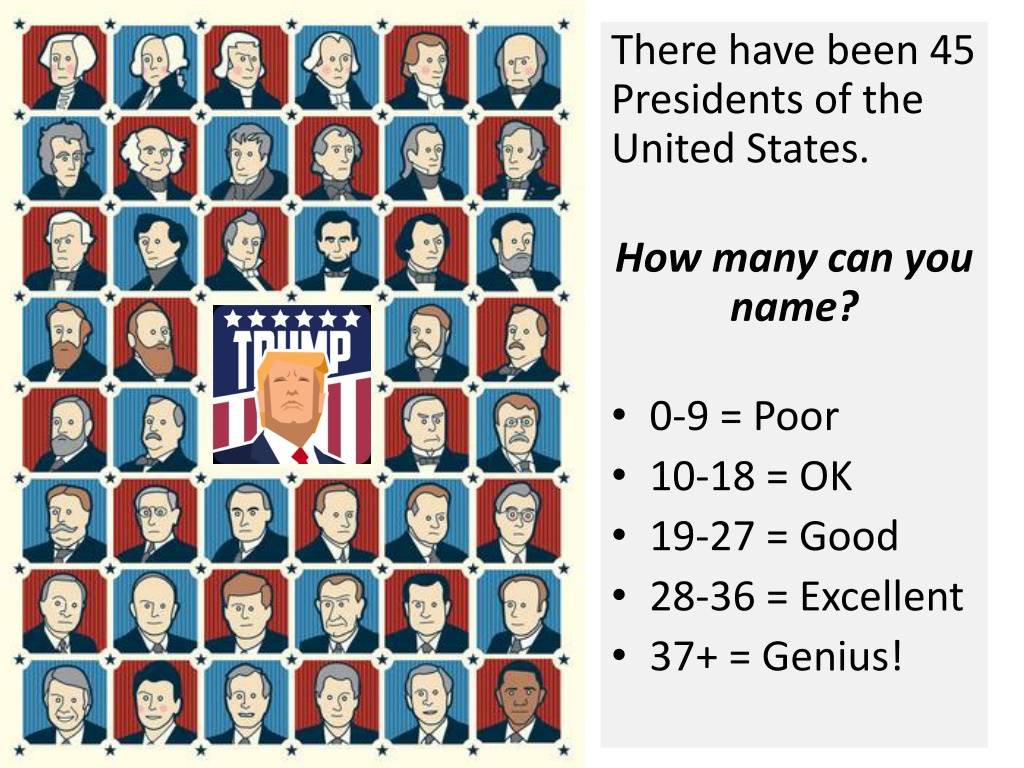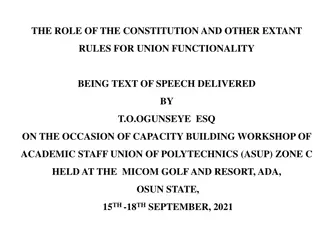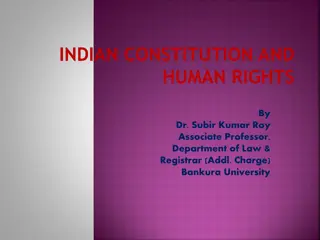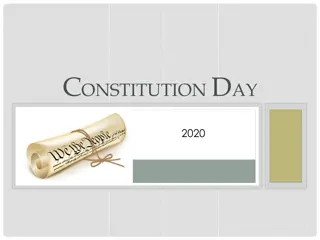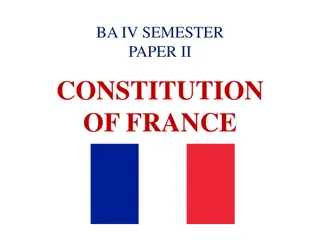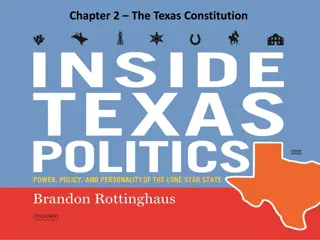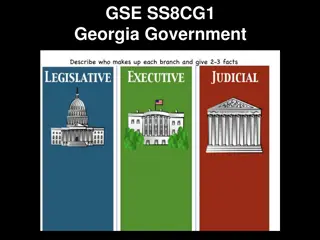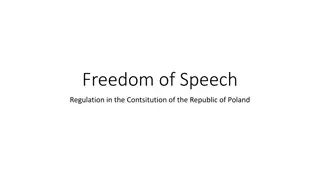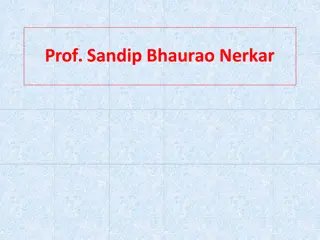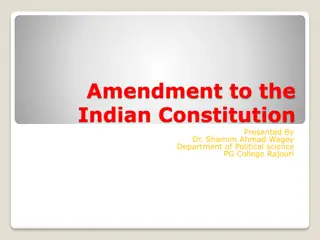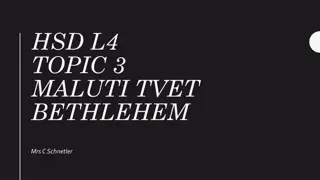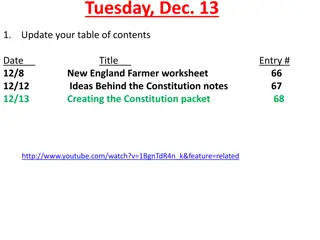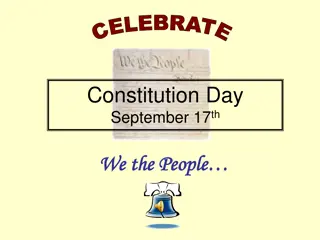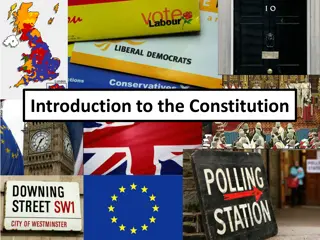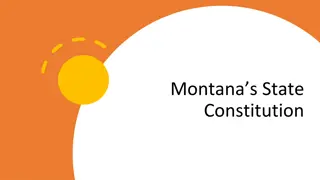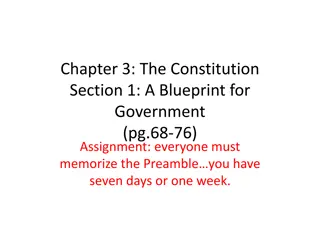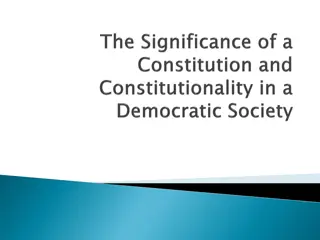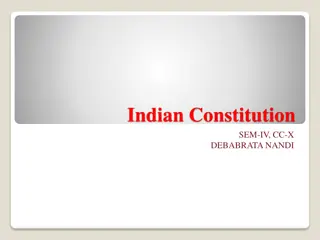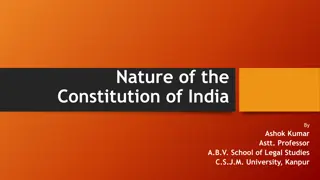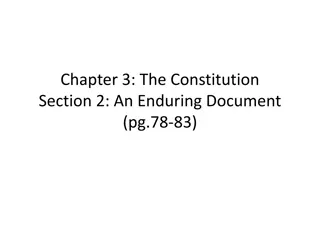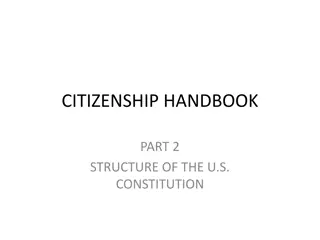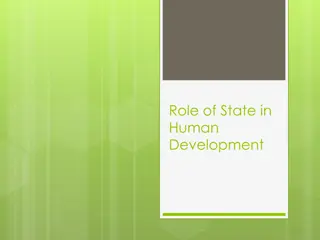Analyzing the US Constitution: Structure and Framework
Explore the US Constitution's framework through document analysis, focusing on the Six Big Ideas that underpin it. Understand the distribution of words in each article, revealing the attention given to government structure and power. Discuss how these concepts align with modern governance and the relative importance attributed by the Founders.
Download Presentation

Please find below an Image/Link to download the presentation.
The content on the website is provided AS IS for your information and personal use only. It may not be sold, licensed, or shared on other websites without obtaining consent from the author. Download presentation by click this link. If you encounter any issues during the download, it is possible that the publisher has removed the file from their server.
E N D
Presentation Transcript
There have been 45 Presidents of the United States. How many can you name? 0-9 = Poor 10-18 = OK 19-27 = Good 28-36 = Excellent 37+ = Genius!
Enquiry Question: What type of government framework does the constitution establish?
Learning Outcomes To analyse the US Constitution to discover the framework of the government it established To identify and exemplify the fundamental concepts the constitution is based on To explore the areas of debate surrounding these fundamental concepts
Document Analysis: The Constitution To understand the Six Big Ideas which underpin the Constitution you need to be familiar with the text itself. Mapping the text of the Constitution allows you to see the attention the Founders gave to the structure and power of government. The 4447 words of the U.S. Constitution are the foundation of the nation and establish the federal government's structures and branches. By counting the words in each article and calculating the percentage of the whole it represents, you can determine how much of the overall constitution was dedicated to each structure or power.
Document Analysis: The Constitution YOUR TASK: Fill out the table on the hand-out to determine the number of words contained in each Article of the Constitution, and the percentage of the whole document that represents. This can be done easily with a digital copy of the text using the word count feature available in most word processing programs use your chrome book/tablet/smart phone to access a digital copy. Map the Constitution by representing the percentages from the table in a visual form on the hand-out. Using different colours for each of the Articles and the Preamble, colour in the squares to represent the percentage of the whole Constitution that is dedicated to each article. Each square represents 1% of the document (round up or down as necessary).
Which topics received the most attention in the Constitution? Does the map suggest hypotheses about the relative importance to the Founders of the powers of the new government? To what extent do the powers of each branch of government displayed in the map match how the federal government works today? Discuss these questions in pairs and be ready to feedback your ideas.
Learning Outcomes To analyse the US Constitution to discover the framework of the government it established To identify and exemplify the fundamental concepts the constitution is based on To explore the areas of debate surrounding these fundamental concepts
Six Big Ideas There are six fundamental concepts and ideas that the US Constitution is based on. For each concept, using your prior knowledge of UK politics and government, discuss in pairs and agree on a definition.
Document Analysis: The Constitution YOUR TASK: You will now analyse the text of the Constitution to identify specific examples of the Six Big Ideas in action. You will be divided into six groups with each group assigned a Big Idea. You will need a copy of the Constitution(printed or electronic). You need to identify two examples of your Big Idea in action. Complete the hand-out with the quote from the Constitution and its location. You will then explain the quote to hone in on its meaning. There will be multiple correct answers for each Big Idea. Each group will share their examples with the class. Example: Separation of Powers- Article II, Section 2, clause 2 says that the Executive "shall have Power, by and with the Advice and Consent of the Senate, to make Treaties, provided two thirds of the Senators present concur." This means that two branches, the President and Congress (the Senate), have to agree before a treaty goes into effect.
Learning Outcomes To analyse the US Constitution to discover the framework of the government it established To identify and exemplify the fundamental concepts the constitution is based on To explore the areas of debate surrounding these fundamental concepts
Debating Political Ideas More than 220 years after the ratification of the Constitution, the Six Big Ideas still inspire debate. Different understandings of how the Big Ideas should be manifested in the actions of the federal government often engender debates over what government should be doing in the name of the people it serves. You will obtain an understanding of these current disputes by taking sides in a debate featuring current issues. YOUR TASK: In pairs you will be assigned a scenario based on one of the Six Big Ideas. One of you will argue for Position A and the other will argue for Position B. You need to identify 5 key arguments (and examples!) to support your position. Work together to discuss the arguments and counter arguments before committing them to your hand-out.
Learning Outcomes To analyse the US Constitution to discover the framework of the government it established To identify and exemplify the fundamental concepts the constitution is based on To explore the areas of debate surrounding these fundamental concepts
How good is your geo-political knowledge? On the blank map of the USA, label as many states correctly as you can.
Homework Application Task: N/A Flipped Learning Preparation Task: Reading and Note Taking: Principles of the US Constitution and their effectiveness today (Edexcel Politics for AS & A Level, Pearson p327-330) Stretch & Challenge Task History.com The Federalist Papers
